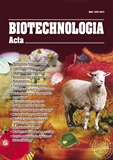ISSN 2410-7751 (Print)
ISSN 2410-776X (Online)

Biotechnologia Acta Т. 16, No. 2 , 2023
P. 21-23, Bibliography 9, Engl.
UDC: 577.2
https://doi.org/10.15407/biotech16.02.021
Full text: (PDF, in English)
DETECTION OF TERNARY COMPLEX OF FIBRIN DESAB WITH D-DIMER AND D-FRAGMENT OF FIBRIN
O. Hrabovskyi 1, M. Syrko 1, 2
1Palladin Institute of biochemistry of the National Academy of Sciences of Ukraine, Kyiv
2ESC “Institute of biology and medicine”
The aim of this work is to study the intermolecular interactions of fibrin with D-domain-containing fragments of fibrin(ogen): D-dimer and D-fragment.
Materials and methods. Human fibrinogen was obtained from the human blood plasma by salt extraction using 16 % Na2SO4. The content of protein coagulated by thrombin – 96-98%.
Analytical size-exclusion chromatography for the detection of molecular complexes was performed on the Sepharose 6B column (30 x 0.5 cm). Components of the analyzed mixture (0.8 ml) were separated by standard chromatography protocol: speed of elution – 0.5 ml/min; collected samples volume – 0.5 ml. Optical density of collected samples was measured by spectrophotometer POP (Optizen, Daejeon, Korea). Composition of each sample was analyzed by SDS-PAGE. Relative amounts of studied compounds in samples were analyzed using densitometry of scanned electropherograms with Totallab TL100 software.
Molecular modeling of complexes formed by fibrin desAB and its fragments were performed using UCSF Chimera 1.16 on the basis on earlier developed protofibril structure.
The structure of the D-region (PDB ID:1LTJ) was prepared in the same
in-protein molecular docking was performed using HDOCK web server.
Results. To investigate the complex formation between fibrin desAB. The appearance of D- and DD-fragments in the elution zone of 5.5 mL, which does not overlap with the elution zone of individual fragments (7.5-9.5 mL), was detected, indicating the formation of a ternary complex. Densitometry of electropherograms using TotalLab TL-100 demonstrated that the average densities of pixels in bands of fibrin desAB, D-dimer and D-fragment were equal. It means that the ternary complex of fibrin desAB with D-dimer and D-fragment was composed in the approximate ratio of fibrin desAB, D-dimer and D-fragment 1:1:1.
Molecular docking in the HDOCK software was used to establish the spatial arrangement of the D-fragment in relation to the fibrin desAB molecule bound to the D-dimer.
Conclusions. We obtained and characterized the ternary complex of fibrin desAB, D-dimer and D-fragment by size-exclusion chromatography followed by SDS-PAGE. Further study of the structure and properties of this complex may clarify certain issues related to fibrin polymerization, namely the process of protofibril formation and their spatial branching.
Key words: fibrin, D-dimer, D-region, fibrin polymerization, docking
© Palladin Institute of Biochemistry of the National Academy of Sciences of Ukraine, 2023
References
1. Weisel J. W., Litvinov R. I. Mechanisms of fibrin polymerization and clinical implications. Blood.
2013; 121(10): 1712–1719. https://doi.org/10.1182/blood-2012-09-306639
2. Riedel T., Suttnar J., Brynda E., Houska M., Medved L., Dyr J.E. Fibrinopeptides A and B release
in the process of surface fibrin formation. Blood. 2011, 3;117(5):1700-6. https://doi.org/10.1182/
blood-2010-08-300301.
3. Lord S. T. Molecular mechanisms affecting fibrin structure and stability. Arterioscler Thromb Vasc
Biol. 2011, 31(3): 494–499. https://doi.org/10.1161/ATVBAHA.110.213389.
4. Gorkun O. V., Veklich Y. I., Medved L. V., Henschen A. H., Weisel J. W. Role of the alpha C domains
of fibrin in clot formation. Biochemistry. 1994, 7;33(22): 6986–97. https://doi.org/10.1021/
bi00188a031.
5. Varetska T. Microheterogeneity of fibrinogen. Cryofibrinogen Ukr. Biochem. J. 1960, 32: 13–24.
6. Wu H.C., Yen C.C., Tsui W.H., Chen H.M. A red line not to cross: evaluating the limitation and
properness of gel image tuning procedures. Anal Biochem. 2010, 1;396(1): 42–50. https://doi.
org/10.1016/j.ab.2009.08.041.
7. Zhmurov A., Protopopova A. D., Litvinov R. I., Zhukov P., Weisel J. W., Barsegov V. Atomic Structural
Models of Fibrin Oligomers. Structure. 2018, 5;26(6): 857–868.e4. https://doi.org/10.1016/j.
str.2018.04.005.
8. Yan Y., Zhang D., Zhou P., Li B., Huang S. Y. HDOCK: a web server for protein-protein and protein-
DNA/RNA docking based on a hybrid strategy. Nucleic Acids Res. 2017, 3;45(W1): W365–W373.
https://doi.org/10.1093/nar/gkx407.
9. Mayer C. L., Snyder W. K., Swietlicka M. A., Vanschoiack A. D., Austin C. R., McFarland B. J. Size-
exclusion chromatography can identify faster-associating protein complexes and evaluate design
strategies. BMC Res Notes. 2009, 15;2: 135. https://doi.org/10.1186/1756-0500-2-135.

